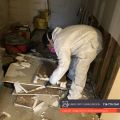Understanding Your Mold Analysis Report: Terms, Types, and What to Do Next
So, you got your mold report back. You’re looking at a list of scientific names, spore counts, and maybe a few red-flag words like “elevated” or “toxigenic.” If you’re feeling overwhelmed, you’re not alone.
The truth is, mold analysis reports often look more intimidating than they are. You don’t need a biology degree to understand them—you just need a clear breakdown of what’s normal, what’s not, and what to do next.
That’s exactly what this guide is here to help with.
First, What Is a Mold Analysis Report?
A mold analysis report is the result of air and/or surface samples collected during a professional mold inspection. These samples are sent to a lab, where technicians identify what types of mold spores are present and in what quantities.
You might see results for:
-
Indoor air samples (taken in rooms of concern)
-
Outdoor baseline samples (for comparison)
-
Surface swabs (from walls, floors, vents, or furniture)
The lab report identifies:
-
The types of mold found
-
Spore counts (how many per cubic meter of air)
-
Whether the levels are considered “normal” or “elevated”
Let’s break down the key terms you’re likely to see.
Mold Types You Might See in Your Report
Here are some common molds identified in lab results—and what they generally mean:
Aspergillus
Very common indoors. Some species are harmless, while others can be allergenic or toxigenic. Elevated levels indoors (especially if not present outdoors) often suggest a mold source inside.
Penicillium
Yes, like the antibiotic—but certain species can cause allergic reactions or asthma issues. Frequently found on water-damaged materials like drywall or carpeting.
Cladosporium
One of the most common outdoor molds but can show up indoors, too. Usually a sign of high indoor humidity or condensation problems.
Stachybotrys (aka “black mold”)
This is the one that gets headlines. It’s a slow-growing mold often found on soaked drywall, paper, or wood, and it can produce mycotoxins. Not always visible, but never something to ignore.
Chaetomium
Another mold often found after long-term water damage. If this shows up, it means moisture has been around for a while.
Basidiospores, Alternaria, Curvularia
These are often outdoor molds that may show up indoors in low numbers—unless there’s poor ventilation or active mold growth nearby.
What Do “Elevated” Spore Counts Actually Mean?
Your report may label certain spore counts as:
-
Low/Normal
-
Slightly Elevated
-
Elevated
-
High/Very High
But what’s the threshold?
Mold spore counts are measured in spores per cubic meter of air (sp/m³). There’s no official legal limit, but as a rule of thumb:
-
Indoor levels should be lower than or similar to outdoor levels.
-
If a mold type appears indoors but not outdoors at all? That’s a red flag—it means the mold is likely growing inside.
-
If you see asymmetrical results (e.g., high in one room but normal in others), the source is likely in that room or nearby.
Example:
If Aspergillus/Penicillium shows up at 600 sp/m³ outside and 5,000 sp/m³ in your bedroom, that’s a strong indicator of indoor mold growth.
What If My Report Says the Mold Is “Toxigenic”?
Toxigenic mold refers to mold species that can produce mycotoxins—harmful substances that may cause respiratory, neurological, or immune symptoms, especially with long-term exposure.
The most commonly flagged toxigenic molds are:
-
Stachybotrys
-
Chaetomium
-
Some strains of Aspergillus and Penicillium
Don’t panic. Just because a toxigenic mold is present doesn’t mean it’s producing toxins right now. But its presence does mean remediation should be taken seriously and handled professionally.
What Should I Do Next?
That depends on your results. Here’s a basic guide:
If mold levels are low or normal:
-
No action is needed. Just keep humidity under control (ideally below 60%) and watch for signs of water damage.
If levels are slightly elevated:
-
Investigate further. There may be minor leaks, poor ventilation, or high humidity. A dehumidifier or minor repair may solve the problem.
If levels are high or toxigenic mold is detected:
-
You likely need professional mold remediation—especially if mold is found in walls, HVAC ducts, crawlspaces, or other hard-to-reach areas.
After remediation, make sure to get post-remediation testing (also known as clearance testing) to confirm the mold is gone and your air is clean.
Why It’s Important to Work With a Certified Mold Inspector
Reading a lab report is one thing. Understanding what it means in the context of your home is another. That’s where a certified mold inspector like myself comes in.
I don’t sell cleanup services, so you can trust that:
-
My findings are unbiased
-
I’ll explain your results in plain language
-
You’ll get honest, clear guidance on what to do next
Serving the Entire Bay Area
Whether you’re in San Mateo, Alameda, Marin, San Francisco, Contra Costa, or Santa Clara, I’ve worked with homeowners, renters, realtors, and property managers across the region to make sense of mold reports and create a safe path forward.
Call (650) 762-6228 or visit https://bayareamoldpros.com to schedule your inspection or get help understanding your mold results.
Final Thought: Reports Don’t Have to Be Scary—If You Know What to Look For
Mold analysis reports can feel technical, but they’re really just tools. When interpreted correctly, they give you the power to take control of your indoor environment, protect your health, and make smart decisions about your home.
Don’t guess. Ask questions. Get clear answers—and breathe easier.








